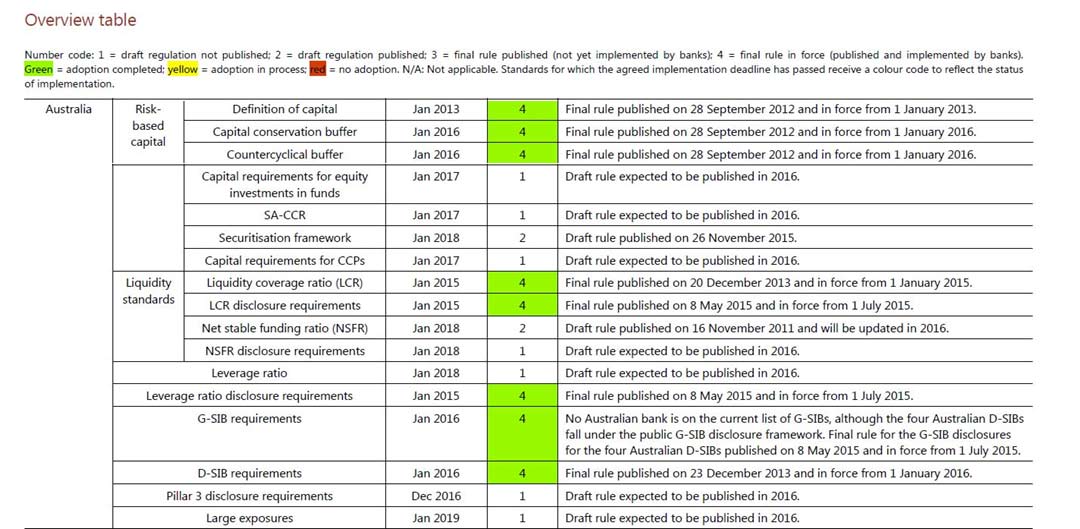The Bank for International Settlements (BIS) has released the 10th status report on the adoption of the Basel regulatory framework. We summarise the elements within Basel III and their target dates, and the status of Basel III in Australia. The complexity of the overall approach is highlighted. It also shows the journey to Basel III is far from complete. Today the IMF Working Paper highlighted the deficiency in the approach in connection with mortgage finance. We are not convinced more complexity is necessarily better.
As of March 2016, all 27 member jurisdictions have final risk-based capital rules, LCR regulations and capital conservation buffers in force, 24 have issued final rules for the countercyclical capital buffers and 23 have issued final or draft rules for their domestic SIBs framework. With regard to the global SIBs framework, all members that are home jurisdictions to G-SIBs have the final framework in force. Members are now turning to the implementation of other Basel III standards, including the leverage ratio and the net stable funding ratio (NSFR).
Regarding the consistency of regulatory implementation, the Committee has published its assessment reports on 24 members – Australia, Brazil, Canada, China, nine members of the European Union, Hong Kong SAR, India, Japan, Saudi Arabia, Mexico, Russia, Singapore, South Africa, Switzerland, Turkey and the United States – regarding their implementation of Basel risk-based capital regulations.
The Basel III framework builds on and enhances the regulatory framework set out under Basel II and Basel 2.5.
• Basel III Capital: In December 2010, the Committee released Basel III, which set higher levels for capital requirements and introduced a new global liquidity framework. Committee members agreed to implement Basel III from 1 January 2013, subject to transitional and phase-in arrangements.
- Capital conservation buffer: The capital conservation buffer is phased in between 1 January 2016 and year-end 2018, becoming fully effective on 1 January 2019.
- Countercyclical buffer: The countercyclical buffer is phased in parallel to the capital conservation buffer between 1 January 2016 and year-end 2018, becoming fully effective on 1 January 2019.
- Capital requirements for equity investment in funds: In December 2013, the Committee issued the final standard for the treatment of banks’ investments in the equity of funds that are held in the banking book, which will take effect from 1 January 2017.
- Standardised approach for measuring counterparty credit risk exposures (SA-CCR): In March 2014, the Committee issued the final standard on SA-CCR, which will take effect from 1 January 2017. It will replace both the Current Exposure Method (CEM) and the Standardised Method (SM) in the capital adequacy framework, while the IMM (Internal Model Method) shortcut method will be eliminated from the framework.
- Securitisation framework: The Committee issued revisions to the securitisation framework in December 2014 to strengthen the capital standards for securitisation exposures held in the banking book, which will come into effect in January 2018.
- Capital requirements for bank exposures to central counterparties: In April 2014, the Committee issued the final standard for the capital treatment of bank exposures to central counterparties, which will come into effect on 1 January 2017.
• Basel III leverage ratio: In January 2014, the Basel Committee issued the Basel III leverage ratio framework and disclosure requirements. Implementation of the leverage ratio requirements began with bank-level reporting to national supervisors until 1 January 2015, while public disclosure started on 1 January 2015. The Committee will carefully monitor the impact of these disclosure requirements. Any final adjustments to the definition and calibration of the leverage ratio will be made by 2017, with a view to migrating to a Pillar 1 (minimum capital requirements) treatment on 1 January 2018 based on appropriate review and calibration.
• Basel III liquidity coverage ratio (LCR): In January 2013, the Basel Committee issued the revised LCR. It came into effect on 1 January 2015 and is subject to a transitional arrangement before reaching full implementation on 1 January 2019.7
• Basel III net stable funding ratio (NSFR): In October 2014, the Basel Committee issued the final standard for the NSFR. In line with the timeline specified in the 2010 publication of the liquidity risk framework, the NSFR will become a minimum standard by 1 January 2018.
• G-SIB framework: In July 2013, the Committee published an updated framework for the assessment methodology and higher loss absorbency requirements for G-SIBs. The requirements came into effect on 1 January 2016 and become fully effective on 1 January 2019. To enable their timely implementation, national jurisdictions agreed to implement by 1 January 2014 the official regulations/legislation that establish the reporting and disclosure requirements.
• D-SIB framework: In October 2012, the Committee issued a set of principles on the assessment methodology and the higher loss absorbency requirement for domestic systemically important banks (D-SIBs). Given that the D-SIB framework complements the G-SIB framework, the Committee believes it would be appropriate if banks identified as D-SIBs by their national authorities were required to comply with the principles in line with the phase-in arrangements for the G-SIB framework, ie from January 2016.
• Pillar 3 disclosure requirements: In January 2015, the Basel Committee issued the final standard for revised Pillar 3 disclosure requirements, which will take effect from end-2016 (ie banks will be required to publish their first Pillar 3 report under the revised framework concurrently with their year-end 2016 financial report). The standard supersedes the existing Pillar 3 disclosure requirements first issued as part of the Basel II framework in 2004 and the Basel 2.5 revisions and enhancements introduced in 2009.
• Large exposures framework: In April 2014, the Committee issued the final standard that sets out a supervisory framework for measuring and controlling large exposures, which will take effect from 1 January 2019.The structure of the attached table has been revamped (effective from October 2015) to monitor the adoption progress of all Basel III standards, which will come into effect by 2019.

